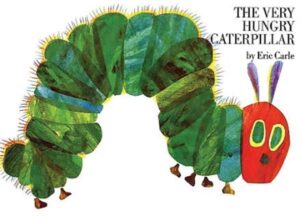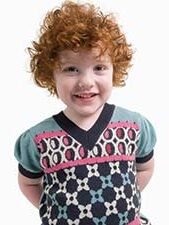Oral language, Print knowledge
Children will understand how Eric Carle used creative illustrations to help readers understand number concepts.

The Very Hungry Caterpillar by Eric Carle

Review:

We are learning about Eric Carle and the books he writes. Yesterday we read The Very Busy Spider. It was about animals.
 [Display book cover.]
[Display book cover.]
Today we will read a book called The Very Hungry Caterpillar. This book helps us understand numbers.
Who remembers reading this book a while ago?
Let’s read the book again and then talk about how Mr. Carle was creative in making illustrations for his book. We know that when we are creative, we use an idea to make or do something.
[Read The Very Hungry Caterpillar.]
Let’s look closely at the page where the caterpillar starts to eat different foods.
Mr. Carle was creative in putting a hole in the page to make it seem like the caterpillar ate through the page in the book. He used one hole for the one apple.
We learned yesterday that Mr. Carle liked to use paint, paper, and other art materials when he was a child. The books he wrote when he became an adult include his creative ideas.
We also learned yesterday that some information in Mr. Carle’s books is made up and some of the information is real.
[Turn to pages with fruit.]
On these pages, the caterpillar eats through different kinds of fruit.
Do we think that real caterpillars eat fruit? (yes)
Caterpillars can eat through different kinds of fruit. This is true. It is a fact.
[Turn to next page with different kinds of food.]
On these pages, the caterpillar eats through many different kinds of food.
Real caterpillars probably would not eat these things. This is something that Mr. Carle made up for the book. Remember, things that are made up are called fiction.
Mr. Carle used creative illustrations in his book called The Very Hungry Caterpillar. The illustrations help us learn about numbers. Mr. Carle also included some information in his book that is made up. We call this fiction. There also is information in his book that is real. We call real information a fact.
Extra support
Enrichment
Provide play food items for children to sort into one of two different groups: foods a caterpillar probably would eat and foods a caterpillar probably would not eat. Encourage children to talk about why each item might or might not be eaten.
Encourage children to look at the Eric Carle books in your setting to see if there are other Eric Carle books which help children understand number concepts. Examples: 1, 2, 3 To the Zoo, 10 Little Rubber Ducks, Rooster’s Off To See The World, My Very First Book of Numbers.
Geometric and spatial knowledge
Children will strengthen their understanding that a new shape can be made by putting together two different shapes.

For Option 2:

For Option 2:
Review:
Offer the first segment of the Week 9, Day 2 activity plan to review how shapes can be combined to make a new shape.
Engage children in a review of how shapes can be used to form a different shape. Demonstrate how triangles can be used to make a diamond shape.
Remind children that we can make a new shape by cutting a square on its diagonal. Display a square. Describe and point to the diagonal (a straight line inside a shape that goes from one corner to another corner, but not an edge). Ask children what shapes are made when a square is cut on the diagonal. (two triangles) Fold the square on the diagonal and cut. Show children the two new shapes. Invite children to describe a triangle. (three straight sides)
Remind children that we also can make a new shape by putting together two different shapes. Demonstrate by displaying two square cutouts of the same size and putting the two squares next to each other to form a rectangle. Describe characteristics of each shape. Put the rectangle in horizontal and vertical positions to emphasize that a rectangle is still a rectangle when we move it to a different position.
Display and invite children to name a diamond shape (pattern block). Describe the shape of a diamond (four equal straight sides and four corners that do not look like the corners on a door). Remind children that when things are equal, they are the same. Display two triangle pattern block shapes. Ask children how we could use two triangle shapes to make a diamond. Put the triangle shapes together as children suggest or invite a volunteer child to demonstrate.
Give each child two triangles and one diamond. Encourage children to arrange their triangles to make a diamond. Children may wish to stack their triangles on top of the diamond or to place the triangles next to the diamond. Invite children to describe how they made their diamond.
Concentrate
Children will use their sense of touch to describe an item held behind their back.


Review:
Concentrate

Science
[Arrange children sitting in a circle.]
Let’s play a game called What’s Behind My Back? We will use our sense of touch to play the game.
What do we use to find out what something feels like? (hands, skin)
 Each of you will have a small item to hold. You will hold your item behind your back. Putting your item behind your back means you cannot see it. You can only feel your item. When I place the item in your hands, do not look at it. Please do not look at your neighbor’s item.
Each of you will have a small item to hold. You will hold your item behind your back. Putting your item behind your back means you cannot see it. You can only feel your item. When I place the item in your hands, do not look at it. Please do not look at your neighbor’s item.
We will concentrate on what the item in our hands feels like. We know that when we concentrate, we pay close attention to something. We will each have a turn to describe our item. We can say whether our item is smooth, rough, hard, soft, small, large, round, short, or long. We can use whatever words will help us figure out what is in our hands. If we know what is in our hands, we need to work hard to not tell others. We want to describe what the item feels like and let others guess what it is!
After each of us describes our item, we will find out if anyone can guess what it is. I will go first.
[Secretly put an item behind your back and describe how it feels. Use simple descriptors. After you have described your item, encourage children to guess what it is. After children have guessed, display the item. If children were correct, ask how they knew. What words were helpful in figuring out what was behind your back? If children did not accurately guess the item, ask what was hard about figuring out what was behind your back.
After brief discussion of experiences in identifying the item in your hand, ask all children to close their eyes and put their hands behind their backs. Walk around the outer circle of children (who are facing inward) and carefully place an item behind the back of each child. Place the item in a child’s hands, if possible (some children may use their hands to cover their eyes).
Give each child a turn, going in the order of circle placement. Remind children to not look at their item. Remind children to describe their item and try hard to not say what it is—if they know!]
Today we played a game called What’s Behind My Back? We used our sense of touch to concentrate on an item behind our back. What was the hardest part of our game? (telling about our item without saying what it was, finding words to describe our item, waiting for our turn, not peeking)
Extra support
Enrichment
Provide a brown paper bag and various items to put in the bag to extend today’s activity. Invite children to describe an item in the bag as others try to guess what it is.
Try this game outside with items found in the play area. Invite children to describe items, such as a stick or leaf.
Knowledge of earth and space
Children will understand the importance of soil to growing plants.

And the Good Brown Earth by Kathy Henderson

Review:

Language / Literacy
We are learning how soil helps plants to grow. We know that soil is also called dirt.
 Today we will read a book about how soil helps vegetables grow in a garden. Remember, a vegetable is the part of a plant that we can eat.
Today we will read a book about how soil helps vegetables grow in a garden. Remember, a vegetable is the part of a plant that we can eat.
[Display book cover.]
Our book is called And the Good Brown Earth. It was written and illustrated by Kathy Henderson. Our book is about growing things in the soil. The book calls soil the “good brown earth.”
[Read the book without interruption unless children ask questions or seem confused about some aspect of the book. At the end of the book, use questions, such as the following, to help children focus on the importance of soil to growing things in the garden:
Today we learned more about how soil helps plants grow. Our book talked about “doing what the good brown earth does best.”
Extra support
Enrichment
Add several artificial plants, seeds, and small gardening items to the sensory table or tub filled with sand or soil. Encourage children to pretend they are planting items in the soil to eat.
Take children to visit a garden plot or field of growing plants. Encourage children to compare the garden or field to the garden described in the book read in today’s activity.